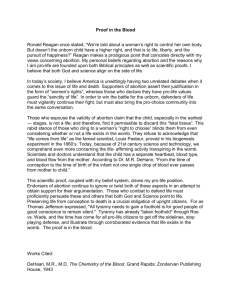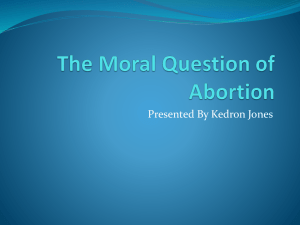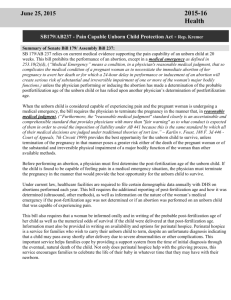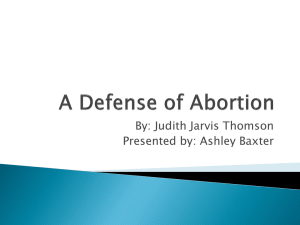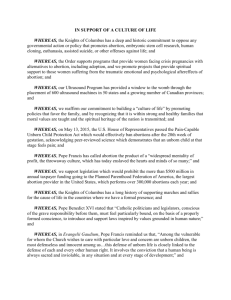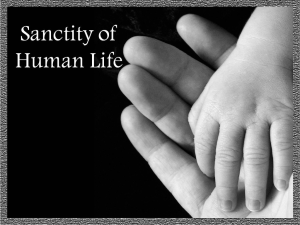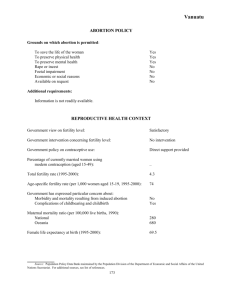Family & Life
advertisement
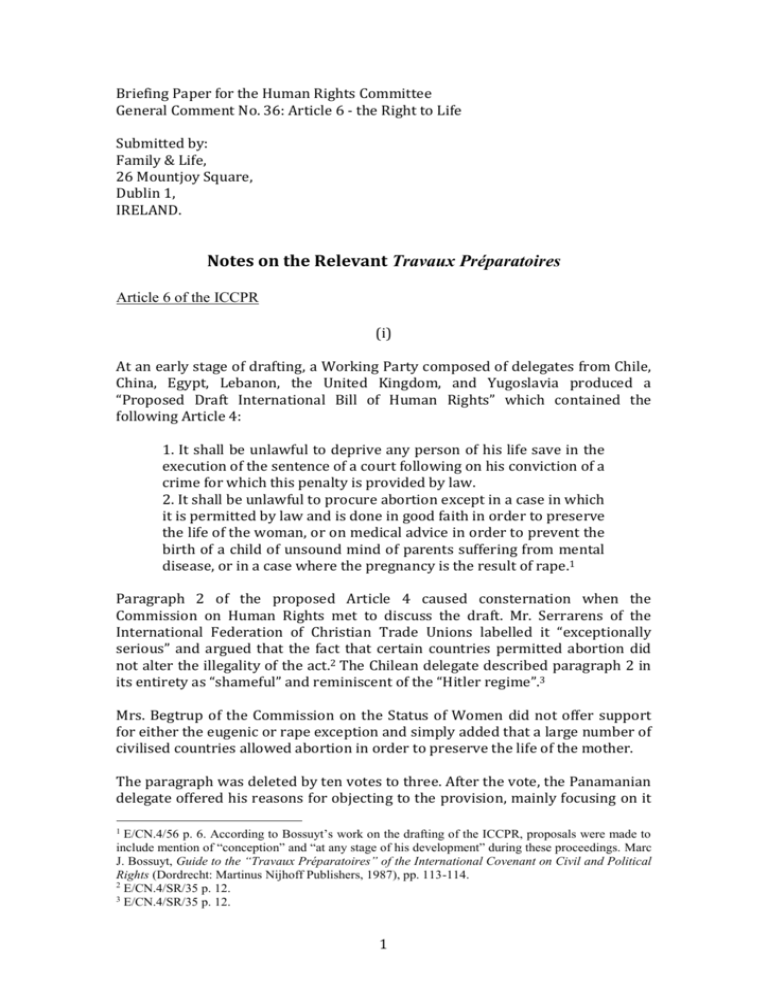
Briefing Paper for the Human Rights Committee General Comment No. 36: Article 6 - the Right to Life Submitted by: Family & Life, 26 Mountjoy Square, Dublin 1, IRELAND. Notes on the Relevant Travaux Préparatoires Article 6 of the ICCPR (i) At an early stage of drafting, a Working Party composed of delegates from Chile, China, Egypt, Lebanon, the United Kingdom, and Yugoslavia produced a “Proposed Draft International Bill of Human Rights” which contained the following Article 4: 1. It shall be unlawful to deprive any person of his life save in the execution of the sentence of a court following on his conviction of a crime for which this penalty is provided by law. 2. It shall be unlawful to procure abortion except in a case in which it is permitted by law and is done in good faith in order to preserve the life of the woman, or on medical advice in order to prevent the birth of a child of unsound mind of parents suffering from mental disease, or in a case where the pregnancy is the result of rape.1 Paragraph 2 of the proposed Article 4 caused consternation when the Commission on Human Rights met to discuss the draft. Mr. Serrarens of the International Federation of Christian Trade Unions labelled it “exceptionally serious” and argued that the fact that certain countries permitted abortion did not alter the illegality of the act.2 The Chilean delegate described paragraph 2 in its entirety as “shameful” and reminiscent of the “Hitler regime”.3 Mrs. Begtrup of the Commission on the Status of Women did not offer support for either the eugenic or rape exception and simply added that a large number of civilised countries allowed abortion in order to preserve the life of the mother. The paragraph was deleted by ten votes to three. After the vote, the Panamanian delegate offered his reasons for objecting to the provision, mainly focusing on it E/CN.4/56 p. 6. According to Bossuyt’s work on the drafting of the ICCPR, proposals were made to include mention of “conception” and “at any stage of his development” during these proceedings. Marc J. Bossuyt, Guide to the “Travaux Préparatoires” of the International Covenant on Civil and Political Rights (Dordrecht: Martinus Nijhoff Publishers, 1987), pp. 113-114. 2 E/CN.4/SR/35 p. 12. 3 E/CN.4/SR/35 p. 12. 1 1 being at variance with a great juridical civilisation, being unscientific, as well as conflicting with a great many national Constitutions. 4 The minute-keeper finished the report of this debate by stating that a cursory review of opinions prevailing among the delegates indicated general support for the Panamanian stance.5 (ii) Roughly ten years after this “abortion proposal”, a joint proposal by Belgium, Brazil, El Salvador, Mexico, and Morocco was submitted: “The right to life is inherent in the human person. From the moment of conception, this right shall be protected by law.”6 Those supporting this “conception proposal” argued that it was a logical extension of the then draft Article 4(5) which protected unborn children whose mothers had been sentenced to death. Those opposing the proposal offered three counter-arguments: (a) it was impossible for the State to determine the moment of conception; (b) the proposed clause involved the question of the rights and duties of the medical profession; and (c) legislation on this issue was based on different principles in different countries and it was therefore inappropriate to include such a provision in an international instrument.7 In the end, the proposal was defeated 31 votes to 20, with 17 abstentions.8 Zampas and Gher conclude on the back of the defeat of this “conception proposal” that Article 6(1) of the ICCPR “rejects the proposition that the right to life attaches before birth”.9 But none of the reasons put forward against the “conception proposal” expressly argued that unborn children do not have human rights or that abortion is protected under human rights law. Taking this specific debate in isolation, it is a fairer representation of what actually happened to characterise it as a vote motivated by concerns relating to subsidiarity. (iii) There are three other important elements of Article 6 and its drafting. As already alluded to, Article 6(5) protects the right to life of unborn children whose mothers have been sentenced to death (“Sentence of death ... shall not be carried out on pregnant women”).10 The travaux préparatoires show that the provision was added out of consideration for “the interests of the unborn child.”11 Secondly, even without the “conception proposal” Article 6(1) begins, “Every human being has the inherent right to life.” This particular wording originated 4 E/CN.4/SR/35 pp. 16-17. E/CN.4/SR/35 p. 17. 6 Bossuyt, Op. Cit., pp. 120-121. 7 Ibid., p. 121. 8 Ibid., p. 121. 9 Zampas and Gher, “Abortion as a Human Right ” (2008) 8 Human Rights Law Review 249, 263. 10 A similar provision is contained in Article 4(5) of the 1969 American Convention on Human Rights. 11 William A. Schabas, The Abolition of the Death Penalty in International Law (3rd edn, Cambridge: Cambridge University Press, 2002), p. 134. 5 2 from two separate proposals, one of which called for the abolition of the death penalty and the other being the “conception proposal”. It was voted through by an overwhelming majority of delegates and contained an implicit though clear natural law stance, “the right to life is not a right conferred on the individual by society.”12 The ordinary meaning of “human being” is quite clear – as a biological term it includes the unborn child. This coheres perfectly with another subsection in the same article, Article 6(5), which clearly recognises the unborn human being as a matter of human rights law. Thirdly, the “abortion proposal” was presented as a derogation from the right to life in certain, limited, circumstances. It was rejected primarily because it was seen as too wide a derogation and failed sufficiently to respect the rights of the unborn, rights the “abortion proposal” implicitly assumed as generally given. The “conception proposal”, on the other hand, was supported solely on the basis that unborn children deserve human rights protection. Its opponents rejected it for a variety of reasons, none of which explicitly argued that unborn children do not deserve human rights protection. Thus out of the four distinct positions put forward on the issue, two explicitly argued that the unborn child possesses human rights (proposing the “conception proposal”, opposing the “abortion proposal”), one implicitly accepted that the unborn child generally possesses human rights (proposing the “abortion proposal”), while the last, opposing the “unborn proposal”, was an admixture of efficacy and subsidiarity concerns. (iv) In summary, outside of the specific debate over the “conception proposal” four other elements of Article 6 and its drafting are pertinent to deciding on the most accurate interpretation of what Article 6 means for unborn human rights. These are Article 6(5)’s protection of unborn children in the realm of capital punishment, Article 6(1)’s natural law type assertion that “Every human being has the inherent right to life”, the fact that subsection 6(5) is coherent to the extent that it is predicated upon subsection 6(1), and the fact that out of the four positions advocated for during drafting on the intersection between abortion and the rights of the unborn, two explicitly supported the principle of unborn human rights, one implicitly supported such a principle to some degree, while the last was a composite position that did not explicitly argue against the principle. (v) Thus the most accurate interpretation of the final text of the ICCPR’s Article 6, one that pays full attention to the ordinary meaning of the text and to the entirety of the various debates, is that the Article does recognise the unborn human as a human rights subject and, although it also represented a sort of 12 Bossuyt, Op. Cit., p. 119. Others have noted the natural law dimension to this article, e.g. Manfred Nowak, U.N. Covenant on Civil and Political Rights: CCPR Commentary (Kehl am Rhein: Engel, 1993), p. 105 (footnote 4). 3 “compromise”, it was not strictly a compromise over whether unborn children do or do not deserve human rights protection. Instead it is more accurately described as a compromise over to what precise extent the human rights of unborn children should be protected, and specifically a compromise over whether abortion in some limited circumstances is a permissible derogation from the right to life of unborn children. Thus the unborn possess human rights according to the ICCPR even if the precise contours of those human rights in relation to limited abortion legislation are left undefined. It is certainly not, therefore, a substantive and sweeping “silence” on the human rights status of unborn children. Further, the travaux préparatoires make it clear that far from abortion being considered a human right, it was instead cast in terms of being a violation of the human right to life. Appendix I: Universal Declaration of Human Rights and the Unborn Child A number of scholars argue that the final text of the UDHR excludes unborn children from human rights protection since Article 1 begins with “All human beings are born free and equal in dignity and rights.” They claim that a proposal was made to delete the term “born” precisely on the basis that it seemed to exclude the unborn from human rights recognition, and that this proposal was rejected.13 But debates over the retention or rejection of the term “born” did not centre on the question of abortion or the moral status of foetal life. Rather they focused on whether or not human rights inhere in human nature or are instead attributed to human beings from some source extrinsic to their very existence, such as society or law.14 As such, the stated rationale for a proposal to delete “born” from Article 1 was that “there should be no implication that people, though born [morally] equal, might lose that equality for any reason.”15 This rationale has nothing to do with assuming that the disputed term (“born”) disqualified pre-natal human beings from human rights protection. See Christina Zampas and Jaime M. Gher, “Abortion as a Human Right - International and Regional Standards” (2008) 8 Human Rights Law Review 249, 263 (“the term ‘born’ was intentionally used to exclude the foetus or any other antenatal application of human rights.”); also, Harold Schmidt, “Whose Dignity? Resolving Ambiguities in the Scope of ‘Human Dignity’ in the Universal Declaration on Bioethics and Human Rights” (2007) 33 Journal of Medical Ethics 578, 582 (“in refusing to make reference to the point of conception, the drafters of the UDHR explicitly placed an important and crucial emphasis on the scope of ‘human dignity’. They established that human dignity and human rights can clearly and with certainty be ascribed only to born human beings.”) 14 Morsink, The Universal Declaration of Human Rights, 1999, pp. 290-293. Tore Lindholm concurs with Morsink on this important point, “the locution ‘are born’ ... was interpreted by most speakers, it appears, to indicate the pre-positive and normative status of freedom and equal dignity”. Tore Lindholm, “Article 1” in Eide and others (eds), The Universal Declaration of Human Rights (Oslo: Scandanavian University Press, 1992), p. 48. See also Johannes Morsink, Inherent Human Rights: Philosophical Roots of the Universal Declaration (Philadelphia: University of Pennsylvania Press, 2009), p. 29. 15 Morsink, Op. Cit., p. 291. 13 4 Thus it is highly misleading to frame the discussion, as Rhonda Copelon and others have done, in terms of an amendment being proposed to delete the term “born” on account of its perceived disregard for the unborn, to be followed by a French rebuttal to the effect that the right to freedom and equality was “inherent from the moment of birth” only.16 As Rita Joseph has pointed out, this particular French rebuttal was aimed not towards those seeking to protect unborn children but against the Soviet suggestion that equality of rights before the law is “determined not by the fact of birth, but by the social structure of the state.”17 If any implication is to be drawn in this regard, it is that the emphasis that the term “born” places on what Morsink properly calls the “inherence” view of human rights, i.e. that human rights inhere in the human condition, constitutes a presumption in favour of the unborn child being a genuine subject of human rights. After all, Article 2 of the UDHR states that “everyone” is entitled to human rights “without distinction of any kind”. Proposals were also made explicitly to include the unborn within the terms of Article 3, dealing with the right to life. One of these was made by the Chilean delegate: “unborn children, incurables, mentally defectives and lunatics shall have the right to life.”18 This proposal would eventually be discussed alongside the proposal of Charles Malik of Lebanon: “Everyone has the right to life and physical integrity from the moment of conception regardless of his or her physical or mental condition. Everyone has the right to liberty and personal safety.”19 These proposals were rejected but not because unborn children do not have human rights or on the grounds that there is a human right to abortion. Two reasons were advanced against their adoption: the need for concision within the UDHR 20 and the fact that not all countries prohibit abortion in all circumstances.21 No delegate argued that unborn children are not entitled to human rights protection per se. For instance René Cassin took a stand against Malik’s proposal on the basis that it was not acceptable to all members, while at the same expressing his agreement with the proposal’s substance.22 Malik is also reported as requesting, that reference should be made in the summary record of the meeting to the statements made by the representatives of China, the Union of Soviet Socialist Republics, and the United Kingdom in connection with [the then] article 4 ... while the delegations of those three countries wished to omit the phrase “from the moment Copelon et al., “Human Rights Begin at Birth” (2005) 13 Reproductive Health Matters 120, 121122. 17 Joseph, Human Rights and the Unborn Child, 2009, p. 57. 18 Morsink, The Universal Declaration of Human Rights, 1999, p. 40. 19 E/CN.4/AC.1/SR.35 p. 4. 20 Eleanor Roosevelt on behalf of the United States, E/CN.4/AC.1/SR.35 pp. 4, 6. 21 Alexei Pavlov, USSR, E/CN.4/AC.1/SR.35 p. 5. 22 E/CN.4/AC.1/SR.35 p. 4. 16 5 of conception” in the interests of brevity, they considered that idea to be implied in the general terms of article 4.23 The Chinese delegate expressly agreed with this point24 while the UK delegate stated, “Article 4 could be understood to contain that idea but did not necessarily do so.”25 The proposals to include “from the moment of conception” and “regardless of his or her physical or mental condition” were each voted on separately and were each defeated six votes to two.26 The proposal explicitly to protect the unborn child was rejected for the sake of succinctness and generality and because its inclusion may have proved an obstacle to some States signing the UDHR. No argument was made against the proposal to the effect that the unborn child does not possess human rights or that there is a human right to abortion. The very most that was argued during the drafting of the UDHR was that the proposal to protect explicitly the right to life of unborn children could not be reconciled with extant legislation providing for abortion in “certain cases”.27 In addition, “everyone” in Article 3 (and 6 and 7) must be understood in light of the preamble’s invocation of “all members of the human family” and Article 1’s reference to “all human beings”. The ordinary meaning of these terms encompasses unborn human beings while, further, the travaux préparatoires make it clear that Article 1’s use of the term “born” signifies the inherence view of human rights, i.e. that human rights inhere in the human condition.28 Appendix II: Treaty Interpretation (i) 23 E/CN.4/AC.1/SR.35 p. 5. E/CN.4/AC.1/SR.35 p. 5. 25 E/CN.4/AC.1/SR.35 p. 5. 26 E/CN.4/AC.1/SR.35 p. 6. An earlier, briefer engagement with the issue proved a prefigurement for this particular debate. Cassin referred to the Chilean and Lebanese proposals (which were in circulation by mid-1947) and stated that “they appeared to expand considerably the idea expressed in this Article [the then Article 7].” E/CN.4/AC.2/SR/3 p. 5. Mr. Vanistendael of the International Federation of Christian Trade Unions followed up by suggesting that the relevant article should include a mention of when life began since the “majority of laws include measures protecting life born or conceived.” He added that the right to life should be guaranteed to everyone regardless of their “physical or mental condition” and that individuals, with specific mention of the working class, should be “able to live their lives in conditions worthy of the human race.” E/CN.4/AC.2/SR/3 p. 7. Mrs. Begtrup of the Commission on the Status of Women responded by arguing that this proposal could not be reconciled with legislation “which in certain cases provided for the right of abortion.” E/CN.4/AC.2/SR/3 p. 8. Cassin ended by stating that the more detailed provisions related to the right to life could be dealt with in a Convention. E/CN.4/AC.2/SR/3 p. 8. 27 Mrs. Begtrup’s statement, E/CN.4/AC.2/SR/3 p. 8. Later that year, during drafting of what was to become the International Covenant on Civil and Political Rights, Mrs. Begtrup indicated that the primary case in mind was provision for abortion in order to save the mother’s life. 28 The “object and purpose” of the UDHR is to protect the human rights of human beings, so a purposive appeal neither adds to nor subtracts from the “ordinary meaning” reading. 24 6 The legal hermeneutic employed above is based on the rules laid down by Articles 31 and 32 of the 1969 Vienna Convention on the Law of Treaties (VCLT).29 As of April 2014 the VCLT has been ratified by 114 states;30 it is regarded as being largely a codification of pre-existing customary international law.31 The VCLT is by far and away the most legally authoritative guide to the accurate interpretation of those international legal treaties which do not delegate to some judicial institution (such as the European Court of Human Rights) the right of authoritative interpretation.32 (ii) The most relevant provisions of the VCLT for present purposes are Article 31(1), “A treaty shall be interpreted in good faith in accordance with the ordinary meaning to be given to the terms of the treaty in their context and in the light of its object and purpose”; Article 31(4), “A special meaning shall be given to a term if it is established that the parties so intended”; and Article 32, Recourse may be had to supplementary means of interpretation, including the preparatory work of the treaty and the circumstances of its conclusion, in order to confirm the meaning resulting from the application of Article 31, or to determine the meaning when the interpretation according to Article 31: (a) leaves the meaning ambiguous or obscure; or (b) leads to a result which is manifestly absurd or unreasonable.33 Article 31(2) further clarifies that a treaty’s context includes the text (incorporative of the preamble and any annexes) itself – thus a holistic approach to textual interpretation is endorsed. It is abundantly clear from Articles 31 and 32 that the “ordinary meaning” of the treaty’s text is the key to its interpretation.34 The “object and purpose” of the treaty shines a light on the 29 These Articles are reflected verbatim in Articles 31 and 32 of the (as yet still inoperative) 1986 Vienna Convention on the Law of Treaties between States and International Organisations. 30https://treaties.un.org/Pages/ViewDetailsIII.aspx?&src=TREATY&mtdsg_no=XXIII~1&chapter =23&Temp=mtdsg3&lang=en, last accessed June 11, 2015. 31 “[T]he Vienna Convention is largely, though not entirely, a codification of the existing customary law of treaties ….” Mark W. Janis, An Introduction to International Law (4th edn, New York: Aspen Publishers, 2003), p. 17; “As for the status of the Convention, most of its provisions either codify customary law or have given rise to rules belonging to the corpus of general law … [t]his instrument is therefore endowed with great significance, even in those areas where it only appears to be potential customary law.” Antonio Cassese, International Law (2nd edn, Oxford: Oxford University Press, 2005), p. 171. 32 The International Court of Justice has repeatedly held that Articles 31 and 32 of the VCLT reflect customary law, see, for instance, Territorial Dispute (Libyan Arab Jamahiriya v Chad) [1994] ICJ 6, at §41; and Oil Platforms, Preliminary Objections (Islamic Republic of Iran v United States of America) [1996] ICJ 803, at §23. 33 Various provisions of Article 31 are of much less significance for the purposes of interpreting the human rights instruments under discussion here, i.e. provisions – designated as clarificatory of the term “context” in Article 31(1) – relating to further conclusory agreements and instruments (Articles 31(2)(a) and 31(2)(b)), subsequent agreements and practices (Articles 31(3)(a) and 31(3)(b)), and other relevant rules of international law (Article 31(3)(c)). 34 “According to the Vienna Convention, treaties are to be interpreted primarily by reference to the term’s of the treaty’s text ….” Janis, An Introduction to International Law, 2003, p. 30. 7 terms of the treaty, meaning that a free-standing “purposive” hermeneutical approach is ruled out.35 Recourse to the travaux préparatoires is warranted when the meaning resulting from the application of Article 31 requires confirmation, or when Article 31 interpretations lead to ambiguity, obscurity, manifest absurdity or manifest unreasonableness. “[G]reat weight was attributed to the purpose pursued by contracting parties, as laid down in the text of the treaty.” Cassese, International Law, 2005, p. 179. 35 8
